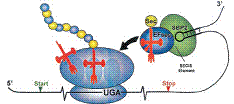Biochemistry, Department of

Vadim Gladyshev Publications
Document Type
Article
Date of this Version
April 2007
Abstract
Chlamydomonas has traditionally been exploited as an organism that is associated with sophisticated physiological, genetic and molecular analyses, all of which have been used to elucidate several biological processes, especially photosynthesis and flagella function and assembly. Recently, the genomics of Chlamydomonas has been combined with other technologies to unveil new aspects of metabolism, including inorganic carbon utilization, anaerobic fermentation, the suite and functions of selenoproteins, and the regulation of vitamin biosynthesis. These initial fi ndings represent the first glimpse through a genomic window onto the highly complex metabolisms that characterize a unicellular, photosynthetic eukaryote that has maintained both plant-like and animal-like characteristics over evolutionary time.


Comments
Published in Current Opinion in Plant Biology 10:2 (April 2007), pp. 190–198. In an issue on the theme of “Genome Studies and Molecular Genetics,” edited by Stefan Jansson and Edward S Buckler. doi:10.1016/j.pbi.2007.01.012 Copyright © 2006 Elsevier Ltd. Used by permission.